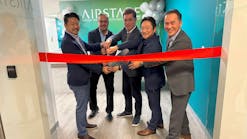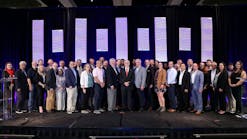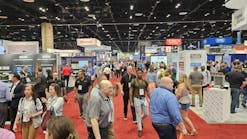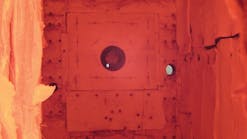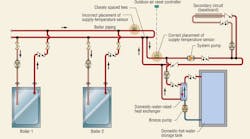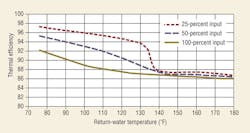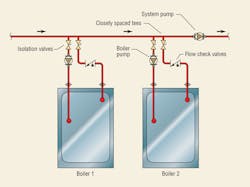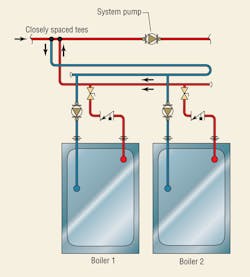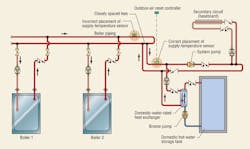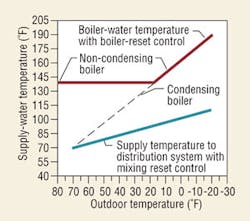Hydronic heating systems are becoming increasingly common in commercial buildings, playing an ever-expanding role in high-performance design. This article discusses tried-and-true methods of minimizing costly mistakes and maximizing efficiency.
Think of a building as a system and a boiler as a component within that system
Boilers do not exist in a vacuum. You could have the most efficient unit, but if it is connected to an inefficient delivery system, what good is it? In many cases, to maximize boiler efficiency, we must also maximize heating-distribution-system efficiency.
Choose your fuel source wisely
When choosing a boiler, consider energy rates, rate structure, and available fuel sources. The 1970s saw the installation of many electric resistance boilers because of low electricity rates. Today, natural gas typically is the lowest-cost fuel source, making gas-fired boilers a popular choice; however, many winter-peaking utilities offer attractive off-peak demand rates, making electric thermal-storage boilers an option. Dual-fuel capability also can help to keep boiler-system energy costs in check. Interruptible gas rates that allow switching of fuel sources during peak times of the year typically are available for large institutional customers.
Balance efficiency with application
Boilers with efficiencies of 80 to 99 percent are available. As counterintuitive as it may seem, a higher-efficiency unit is not always the answer. For example, in a retrofit application, installation constraints may dictate replacement with a similarly efficient product. And in the case of a multiple-boiler replacement, while you will want to consider a higher-efficiency unit for the lead boiler, the one handling the off-peak conditions that occur 80 to 90 percent of the time, a lower-efficiency unit may be fine for the lag boiler, the one handling the peak conditions that occur the other 10 to 20 percent.
Match boiler to load
Whether you are selecting a boiler for a new building or retrofitting an existing boiler, consider your needs for redundancy, and calculate your heating loads. Factors affecting replacement-boiler sizing include changes in building envelope (e.g., new windows, doors, and/or roof), reduced internal loads from computers and equipment, and increased heating load from a lighting retrofit or change in occupancy type. If a wide load range exists, consider either separate boiler systems for space heating and domestic hot water or a multiple-boiler central system to ensure maximum efficiency.
Reduce supply-water temperature
A reduction in supply-water temperature generally increases boiler efficiency for several reasons. First, it increases runtime, reducing cycling losses. Second, low supply-water temperature means low return-water temperature, and for condensing boilers in particular, the lower the return-water temperature, the greater the efficiency. Methods of reducing supply-water temperature include designing around low-temperature heat emitters, such as radiant systems, and selecting heating coils with two rows instead of one. The marginal cost premium for a condensing boiler and slightly larger-capacity heat emitters is paid back many times over through lower utility costs year after year.
Increase temperature differential
Historically, low-temperature hot-water heating systems have been designed for a seemingly arbitrary temperature drop of 20°F. Increasing this differential yields pumping savings and pipe-size reductions, as well as higher source efficiency through lower return-water temperatures. For example, doubling the differential from 20°F to 40°F halves the required flow rate.
One way to increase temperature differential is to employ a multiload hydronic system, which, for example, may incorporate baseboard convectors operating at 180°F, panel radiators requiring 160°F, and radiant tubing peaking at 120°F. Multiload hydronic systems offer benefits including higher seasonal efficiency from increased duty cycle, load diversity, lower installation and maintenance costs, and reduced space requirements. When supply-water temperatures of secondary loads vary, employ series primary loops. When supply-water temperatures of circuits are similar, use parallel primary-secondary or “split-primary” piping.
Introduce variable-speed pumping
Variable-speed pumping improves load tracking while realizing pump electrical savings. At 50-percent load, a pump consumes only one-eighth the power it would at 100-percent load because of pump affinity laws. Variable-speed pumping systems typically are controlled by differential pressure; however, differential-temperature controllers have entered the North American market.
Historically, boiler systems employing variable-speed pumping were of the primary-secondary variety, with the primary pumps constant speed and the secondary pumps variable speed. Today, many boilers can accept variable flow, and “variable-flow-primary” systems are gaining wider acceptance. Variable-flow-primary systems use one pump to pump both a boiler and system, reducing installation cost. When applying variable flow through boilers, be sure to consider the boiler’s minimum flow rate, and set pump minimum flow accordingly.
Select high turndown—reduce equipment cycling
The efficiency of non-condensing boilers can be increased by reducing cycling time. This can be accomplished through selection of higher 10:1 turndown or modular systems offering an effective turndown.
Condensing boilers recover additional heat from flue gas, achieving efficiencies of 88 to 99 percent. Condensing boilers, however, are among the most misapplied elements of modern hydronic systems. A typical condensing-boiler efficiency curve is shown in Figure 1. As can be seen, at return-water temperatures above 130°F, the full potential of the boiler cannot be realized. Additionally, the boiler operates significantly better at part load than it does at full load. Apply a control strategy that exploits the efficiency curve and reduces cycling losses. For example, in a two-boiler system, operate the first boiler at up to 50-percent load, then bring on the second boiler so each operates at 25-percent load.
Do not be afraid to apply condensing boilers in high-temperature systems
Condensing boilers commonly are thought to be inappropriate for hot-water systems designed to operate at temperatures above 140°F, such as existing perimeter baseboard heating or variable-air-volume systems with reheat. It is important to remember these are design temperatures, which occur only a small percentage of the year; for much of the rest of the year, loads can be met with much-lower-temperature water. Additionally, in this author’s experience, older baseboard systems may be oversized to begin with, offering the ability to meet loads with lower-temperature water. During off-hour heating, when response time is not as critical, a lower water-temperature setpoint can be used, further increasing efficiency.
Pipe boilers in parallel
shows a series-piped boiler arrangement. The boilers have individual pumps and check valves and closely spaced boiler tees, all effective in preventing unwanted flow through unfired boilers. The series arrangement, however, prevents the lowest-temperature return water from entering the boilers. A more appropriate solution would be to pipe the boilers in parallel, as shown in Figure 3. The goal with boiler piping is to provide parallel-piped, independent flow. This reduces system pumping pressure and prevents an unfired boiler from becoming a heat emitter.
Locate control sensors in constant-flow areas
Figure 4 shows a boiler supply sensor improperly located on boiler-manifold piping. Normally, boiler pumps operate only when there is a call for heating. With this sensor placement, when boiler-manifold temperature is satisfied, boiler circulators are off, but a load may still exist in the distribution system. Residual boiler-manifold heat then becomes trapped. When heat is needed in the system, the boilers will not fire.
Boiler supply sensors should be located in areas of constant flow to maximize the use of boiler heat and to ensure heat is delivered when required.
Employ water-temperature reset
Applicable to both primary and secondary heating loops, supply-water-temperature reset (Figure 5) can go a long way toward reduced energy consumption and cost. Also, it can improve the ability to track building load, resulting in reduced equipment-cycling-related heat loss.
As shown in Figure 1, condensing boilers typically are most efficient when return water is coldest. When employing supply-water-temperature reset, determine the lowest supply temperature that will satisfy the minimum boiler return-water temperature. Non-condensing boilers typically have a minimum return-water temperature to prevent flue-gas condensation and premature corrosion-related failure.
Practice preventive maintenance
To maintain peak combustion efficiency throughout a boiler’s life, have the boiler serviced by qualified personnel routinely. As with any mechanical system, preventive maintenance of boilers serves to protect your investment and ensure peak performance over the life of the system.
A member of HPAC Engineering’s Editorial Advisory Board, Peter D’Antonio, PE, CEM, LEED AP, is president of PCD Engineering Inc., provider of building energy analysis, mechanical/electrical design, and commissioning. His work has been recognized with design and service awards from organizations such as the U.S. Environmental Protection Agency, the U.S. Green Building Council, the Colorado Governor’s Energy Office, and the Colorado Renewable Energy Society.
Did you find this article useful? Send comments and suggestions to Executive Editor Scott Arnold at [email protected].
